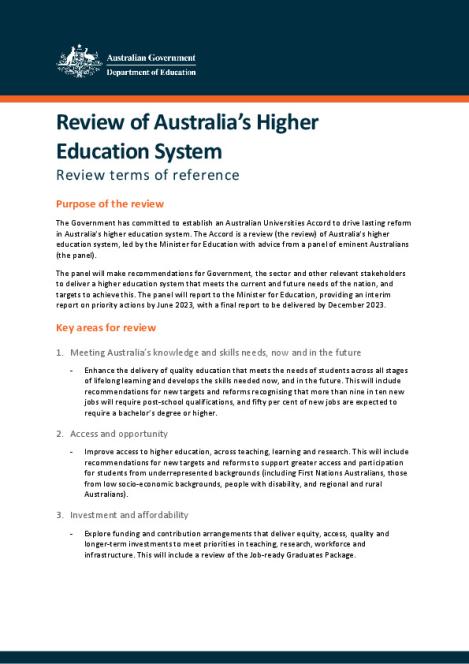The Review has asked for priorities. I suggest no radical change is needed. Universities should continue to provide educated professionals for the workplace, and applied research for industry, supported by fundamental research. Better funding of, and linkage with the VET sector is needed. This can be facilitated by training university academics in how to teach, using the work integrated techniques used in VET. Australia should double down on the use of online blended, and mobile learning, and promote this for international students. Government should target strategic areas for HE/industry cooperation, starting with a $20B defence drone program.
Recommendations on the Review Topics
1. Meeting Australia’s knowledge and skills needs, now and in the future
Recommendation 1: Australian universities should continue to be funded to focus on educating professionals, conducting applied research for industry, supported by fundamental research. The funding for the Vocational Education and Training (VET) sector in preparing professionals, both before and after university, should be expanded.
Discussion: Universities should continue to provide first, and advanced degrees, with some vocational institutions offering first degrees, and other shorter qualifications. All should offer options for competency based, stacked short qualifications, with work integrated learning, and project capstones, as recently announced by Singapore Institute of Technology.
From the establishment of the first university, the top priority for Australian higher education has been to educate professionals for the workforce. The second priority has been applied research, in support of industry. Both education and applied research have been supported by fundamental research. There is no need to change these priorities.
Alongside universities, have been vocational institutions, providing more focused courses, and providing specific skills needed immediately. Schools have also been able to provide vocational qualifications, as well as preparation for university. A minority of jobs will require a bachelor's degree, or higher, as the specific skills required will be specified using small skills units, which can be obtained via industry certification, VET, or university.
2. Access and opportunity
Recommendation 2: Government funding should be contingent on universities continuing to offer online, blended, and mobile learning, as a way to enhance access for those who can't get to a campus regularly. Qualifications be required to be stacked, so that students will receive a worthwhile outcome from months of study, while still being able to go on to a multi-year one.
Discussion: hose from First Nations, low socioeconomic backgrounds, disability, regional and rural areas, have been underrepresented at Australian universities, both as students and staff, in part because they simply could not get to a campus. Online access can help correct this form of discrimination, further enhanced with a mobile option (Cochrane, Et. al, 2020). Allowing for online and hybrid access also forces better design of courses and work, lowering other more subtle barriers to access. The Australian government should make online access for staff and students a condition of funding.
COVID-19 caused Australian higher education, & much of the research effort, to move online. For those trained to teach and work online in a pandemic emergency, this was less challenging (Worthington, 2020, & 2006).
However, most students were already undertaking most of their studies online pre-COVID, even when officially enrolled on-campus. Researchers also collaborated online, across campus, the continent, and the world. The pandemic made these practices official. Australian institutions should build on the work done during COVID-19, with training provided for staff in how to teach, and work in teams online.
Having shown it is possible to provide an online option for staff and students, universities have a legal obligation to continue to do so. Remove the online option would unlawfully discriminate against those who cannot be there in person, for reasons of economic circumstance, disability, family care, community, or cultural obligations.
3. Investment and affordability
Recommendation 3: Governments fund VET programs for new students, nested with intermediate programs at university. All programs would have the option of competency based assessment, and recognition of prior learning. Funding be provided for university academics to be trained in how to design and teach using these techniques.
Discussion: The lowest cost course is one the student doesn't have to do. If the student already has the required skills and knowledge, there is no need for them to do a course, and they can move on to something more advanced. This approach is well established in the Vocational Education Sector, but not higher education. It requires staff trained in how to carry out experience based assessment, and to accept qualifications of other institutions. It also requires embracing competency based assessment, which university academics are reluctant to do. These staff need training in how to perform such assessment, and be familiar enough with it that they are willing to accept it.
4. Governance, accountability and community
 |
| Anduril Dive-LD Ghost Shark XL-AUV, made in Sydney |
 |
| Boeing MQ-28 Ghost Bat UAV, made in Queensland. |
The Boeing MQ-28 Ghost Bat stealth unmanned aerial vehicle (UAV) which is made in Queensland, and Anduril Dive-LD Ghost Shark extra-large autonomous undersea vehicle (XL-AUV) recently completed in Sydney, show potential. The Australian Higher education sector has already assisted through activities such as the Navy Warfare Innovation Workshop 2020, which featured drones. Funds diverted from the nuclear program could make Australia a world leader in drones.
5. The connection between the vocational education and training and higher education systems
Recommendation 5: Governments fund university academics in the teaching techniques and course design approaches, including online, blended, work integrated, and other techniques used in VET.
Discussion: A striking feature of the Australian education system is how the higher the level, the less teaching qualifications are required. School teachers are required to have at least a first degree, and increasingly an advanced degree in teaching. VET teachers need at least a Certificate IV in Training & Assessment. However, university academics are expected to teach, and design learning, without any AQF qualification.
Connecting VET and universities would be much easier if universities had staff qualified to teach. It would help if the teaching include the techniques used in the VET sector, both to improve the quality of university teaching, and allow better integration with the VET sector. This doesn't require university academics sitting in lecture halls listing to lectures on teaching. In fact they should not be doing that, and instead learning online, while teaching.
6. Quality and sustainability
Recommendation 6: Discontinue the New Colombo Plan program, and instead fund university programs which allow domestic and international students to learn together collaboratively online.
Discussion: After a virus closed campuses in 2003, the National University of Singapore conducted an annual "E-learning Week", to practice teaching online in an emergency (Chandran, 2010). The Australian Government, and universities therefore had plenty of warning of the possibility of a pandemic, and prudent precautions to take. Unfortunately Government, and most universities, failed to prepare for this known risk. As a result universities had to put in place ad-hoc online learning, using staff untrained for the challenge.
International students could again be kept offshore by a regional security crisis (Worthington, 2017). Also Australian universities face increasing international competition. Rather than just retreat into serving a shrinking premium market for onshore courses, Australian institutions can also offer premium online and blended programs. This can be done by training staff in how to teach online, and challenge the myth that online learning is inferior in quality. This learning can be engaging, and offer international students the chance to study with Australians (Worthington, 2014).
7. Delivering new knowledge, innovation and capability
Recommendation 7: Governments fund training for undergraduate, and graduate students to learn commercialisation techniques, at centres such as the Canberra Innovation Network, while receiving course credit, as exemplified by the ANU Techlauncher program (Worthington, 2019).
Discussion: For university research to deliver practical outcomes, researchers need to learn commercialisation skills. It is not sufficient for a researcher to pass on their discoveries for others to commercialise, they need to be actively involved. This training is best done at the innovation centres located near universities, in partnership with local, state government, and industry. This training should be integrated with formal programs of study, not as an optional extracurricular activity.
References
Terms of Reference, Review of Australia’s Higher Education, Department of Education, Australian Government, 10 November 2022. URL https://www.education.gov.au/australian-universities-accord/resources/terms-referenceResponding to the Coronavirus Emergency with e-Learning, Worthington, Tom, Athabasca University, April 17, 2020. URL https://news.athabascau.ca/beyond-50/responding-to-the-coronavirus-emergency-with-e-learning/
Wireless Web System for an Avian Influenza Pandemic, Worthington, Tom, Australian National University, March, 2007. URL https://www.tomw.net.au/2005/wd/sahana3.shtml
Digital Teaching In Higher Education: Designing E-learning for International Students of Technology, Innovation and the Environment, Worthington, Tom., 2017. URL http://www.tomw.net.au/digital_teaching/introduction.shtml
Chinese and Australian students learning to work together: online proposal to expand the New Colombo Plan to the online environment. Worthington, T. (2014, August). In 2014 9th International Conference on Computer Science & Education (pp. 164-168). IEEE. URL https://doi.org/10.1109/ICCSE.2014.6926448

No comments:
Post a Comment